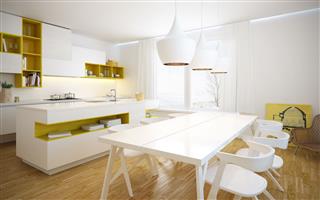
It is difficult to choose kitchen countertops material as various types of stones are available in market. Are you thinking of using limestone for kitchen countertops? This article will help you decide about the countertop material; as it provides information on limestone countertops pros and cons.
It is always difficult to choose the perfect kitchen countertop material from various available materials. Toughness, durability and quality are to be taken into consideration while choosing kitchen countertops. Granite countertops are popular for these qualities. You can even combine different materials in a unique way. You may choose a cool-to-the-touch marble for the baking area and slate around the cooking top, and granite by the sink. Taking into consideration customer reviews and the cost, you can decide where to have limestone and where to have granite or marble or any other stone. Before taking the final decision, do not forget to ask the supplier about the maintenance cost of marble, granite and limestone countertops.
Limestone Countertops Pros and Cons
- Some varieties of limestone make excellent countertops, some don’t.
- You may use softer varieties around fireplaces and in bathrooms.
- Limestone can be molded easily without affecting the existing structure.
- You should use cutting boards for knives, if the material used for the countertop is limestone.
- Limestone is cheaper than granite but the cost of maintenance of limestone may be more than that of granite.
- Only the harder, denser types, especially those quarried in France and Germany, can be installed in the kitchen. They are as good as granite.
- Limestone is one of the most versatile stones, as it is always available in various sizes, textures and soft colors, giving a luxurious look and adding warmth to your kitchen.
- Trivets should be used to place hot pots on limestone tops, since limestone does have the potential to burn. Never place hot pots and pans directly on the countertops that are made from limestone. Trivets and place-mats help avoid scratching.
- You should wipe spills immediately and in order to avoid etching, you should use only those cleansers that are specified for limestone. You may store perfumes and other such material on a sheet of glass to protect vanity limestone surfaces.
- Limestone is acid sensitive. Calcareous stones readily dissolve in acid. Lemon or tomato juice are acidic and if spilled on limestone tops, can severely damage the surfaces. Acidic products can cause limestone to etch – the surface finish will appear dull and texture will also change.
- Maintaining the countertops made from limestone is a tedious job; because soft and porous limestone can scratch and stain easily. Soft countertops etch quicker than the denser varieties. Sealing can prevent staining, but it cannot stop problems with etching. This becomes a serious problem when dark-colored limestone is used for kitchen countertops. All types of limestone require regular application of a good penetrating sealer.
The following table provides information on basic facts of some of the commonly used countertop materials; and pros and cons of each material.
Various Materials Used for Countertops:
| Description | Granite | Marble | Limestone |
| Nature | Natural, very hard, made up of quartz and feldspar, unique beauty and longevity | Natural but soft, porous material. | Made up of calcite, a neutral-toned mineral, often contains remains and fossils of sea creatures, varies in hardness, some softer like marble, some harder like granite, some can break off easily. |
| Reaction to Heat and Scratch | Extremely heat and scratch-resistant, you can place hot pans directly on the surface. | Heat and water-resistant. | Some harder varieties are heat and scratch resistant like granite. |
| Staining and Scratching | You can employ various methods to remove the stains, success will depend on the type of stain. A professional only can repair the scratches. Proper periodic resealing with a penetrating sealer, at least once every couple of years can prevent staining. | Stains and scratches easily. | Requires proper periodic resealing with a penetrating sealer which helps prevent staining. |
| Specific Tasks | Cutting on granite surfaces should be avoided. | Good for rolling out pastry dough. | In kitchen, ideal for pastry-rolling. You can use softer varieties in bathrooms or around fireplaces. |
| Availability | Limited sizes, so for larger areas, slabs need to be placed together. Lot of varieties, various edge treatments possible and polished, honed and matte finishes available. | Varieties in honed, matte and polished finishes. | Varieties in black, gray, brown, white and yellow colors, have smooth, muted complexion. A matte finish is more popular. |
| Price Range | Prices range from $100 to $300 per linear foot depending on availability, quality and the quantity required. | From $50 – $100 per square foot fabricated. | From $50 – $100 per square foot fabricated. |
You should browse limestone countertops reviews before placing the order of the countertops. You may have to spend some time on research but it is necessary to know the advantages and disadvantages of the stone that you are going to use to decorate your kitchen and bathroom.








